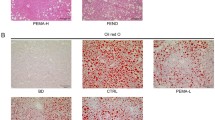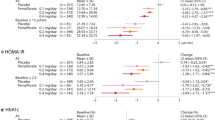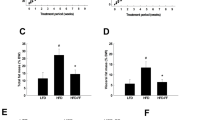Abstract
In rodents fenofibrate shares with other triglyceride-lowering agents the potential to increase the liver peroxisome population. It was therefore of interest to look for this effect in hyperlipoproteinemic patients receiving this drug.
Light and electron microscopy of liver biopsies from a group of 10 patients treated with fenofibrate and from another group of 15 receiving diet only, show no morphological difference between both groups. In contrast with the rodent data the morphometric study reveals no significant changes in the number (fenofibrate group: 7.96 1010 cm−3; group receiving diet alone: 8.41 1010 peroxisomes/cm3 of liver tissue) or in the size (fenofibrate group: Diameter=0.53±0.07 μm — group receiving diet alone: 0.50±0.06) of peroxisomes.
The difference between our results and those obtained consistently in rodents may be due to the relatively low dose in man and/or a species-dependant difference in enzyme content of liver peroxisomes, itself related to an apparent difference in the way in which lipids are handled.
Similar content being viewed by others
References
Barnard SD, Molello JA, Caldwell WJ, Le Beau JE (1980) Comparative ultrastructural study of rat hepatocytes after treatment with the hypolipidemic agents: probucol, clofibrate and fenofibrate. J Toxicol Environ Health 6:547–557
Beaumont JL, Carlson LA, Cooper GR, Fejfar Z, Frederickson DS, Strasser T (1970) Classification of hyperlipidemia and hyperlipoproteinemia. Bull WHO 43:891–915
Blane GF, Pinaroli F (1980) Fénofibrate: étude en toxicologie animale en rapport avec les effets secondaires chez les malades. Nouv Presse Méd 9:3737–3746
Ghadially FN (1975) Microbodies. In: Ghadially FN (ed) Ultrastructural pathology of the cell. Butterworths, London, pp 369–379
Kemmer C, Hannefeld M (1977) Ultrastrukturelle Befunde und Leberpunktate von Patienten mit Hyperlipoproteinemia. Zentralbl Alg Pathol 121:243–253
Kessler G, Lederer H (1965) Fluorometric measurement of serum triglycerides. In: Skeggs LT (ed) Automation in analytical chemistry. Technicon symposia. New York, pp 341–344
Ma MH, Biempica L (1971) The normal human liver cell, cytochemical and ultrastructural studies. Am J Pathol 62:353–390
Ma MH, Goldfischer S, Biempica L (1972) Morphology of the normal liver cell. In: Popper H, Schaffner F (eds) Progress in liver diseases. Grune and Stratton, New York, pp 1–37
Reddy KJ (1981) Toxicologic implications of drug induced hepatic peroxysome proliferation. In: Zbinden G (ed) Lecture in toxicology. Pergamon Press, Oxford, pp 1–11
Reddy JK, Azarnoff DL, Hignite CE (1980) Hypolipidaemic hepatic peroxysome proliferators form: a novel class of chemical carcinogens. Nature 283:397–398
Rohr HP, Oberholzer M, Bartsch G, Keller M (1976) Morphometry in experimental pathology: methods, baseline data and applications. In: Epstein MA (ed) Intern Rev Pathol, vol 15. Academic Press, New York, pp 233–322
Sezille G (1976) Lipoproteinogramme sur gel de polyacrylamide en gradient discontinu. In: Sezille G, Fruchard JC, Jaillard J, Dewailly P (eds) Lipides et lipoprotéines. Cronan Roques, Lille, pp 92–95
Stötzner H (1975) Histologische Leberbefunde bei primärer Hyperlipoproteinemia. Dtsch Gesundh Wes 30:312–314
Weibel ER, Kistler GS, Scherle WF (1966) Practical stereological methods for cytology. J Cell Biol 30:23–38
Zlatkis A, Zak B, Boyle AJ (1953) A new method for the direct determination of serum cholesterol. J Lab Clin Med 41:486–492
Author information
Authors and Affiliations
Rights and permissions
About this article
Cite this article
Gariot, P., Barrat, E., Mejean, L. et al. Fenofibrate and human liver. Arch Toxicol 53, 151–163 (1983). https://doi.org/10.1007/BF00302723
Received:
Issue Date:
DOI: https://doi.org/10.1007/BF00302723




